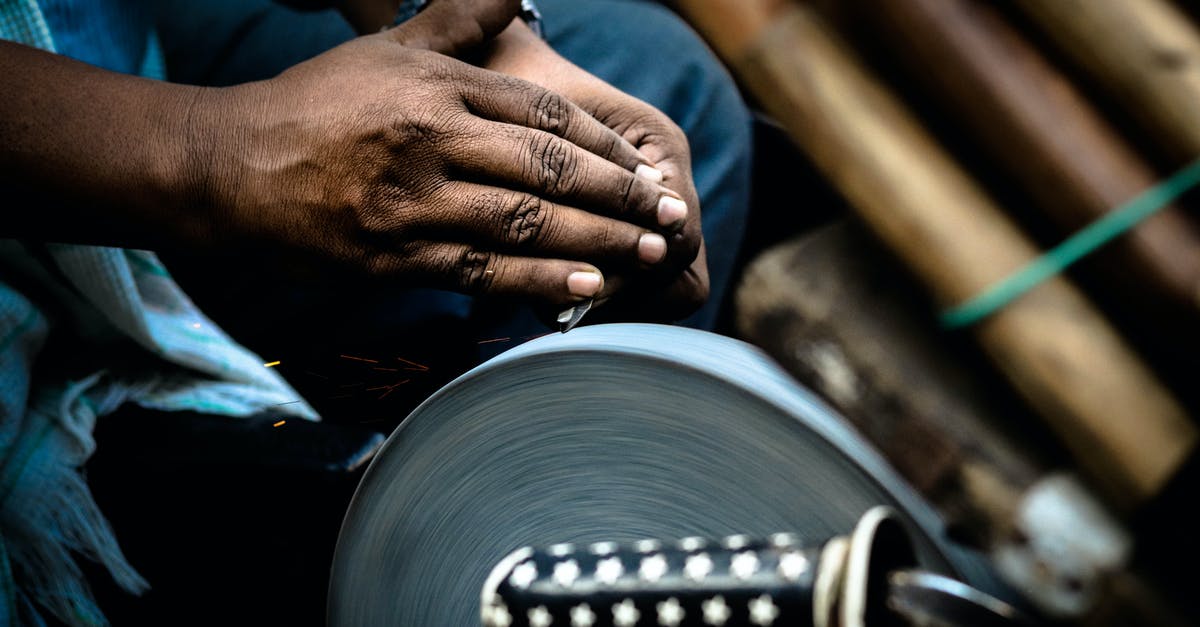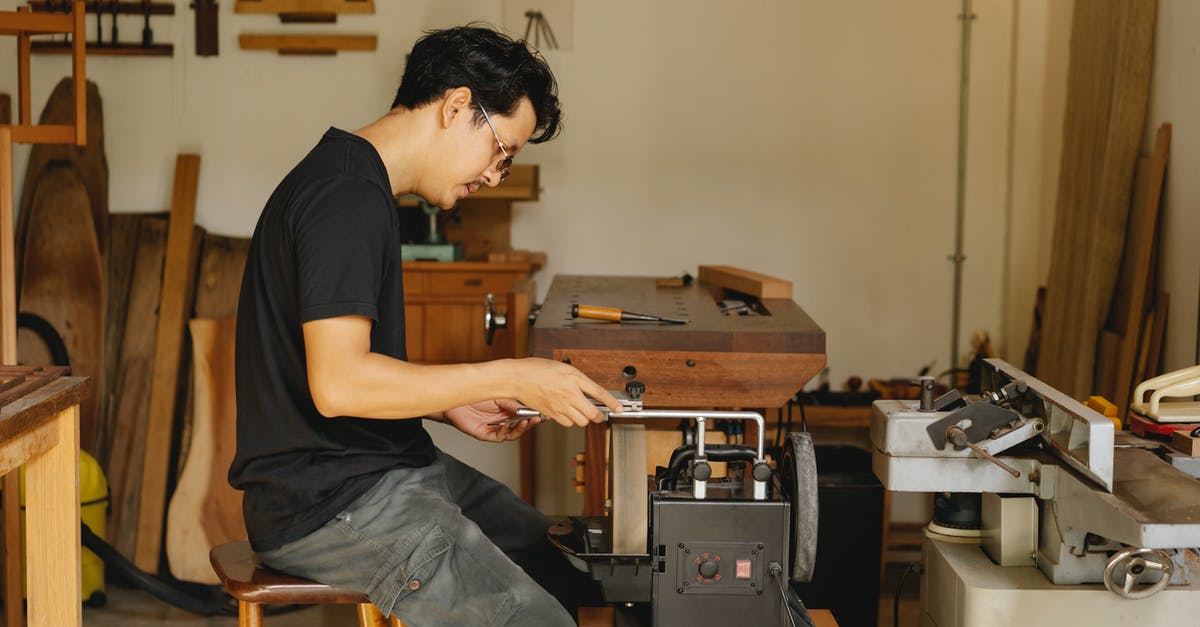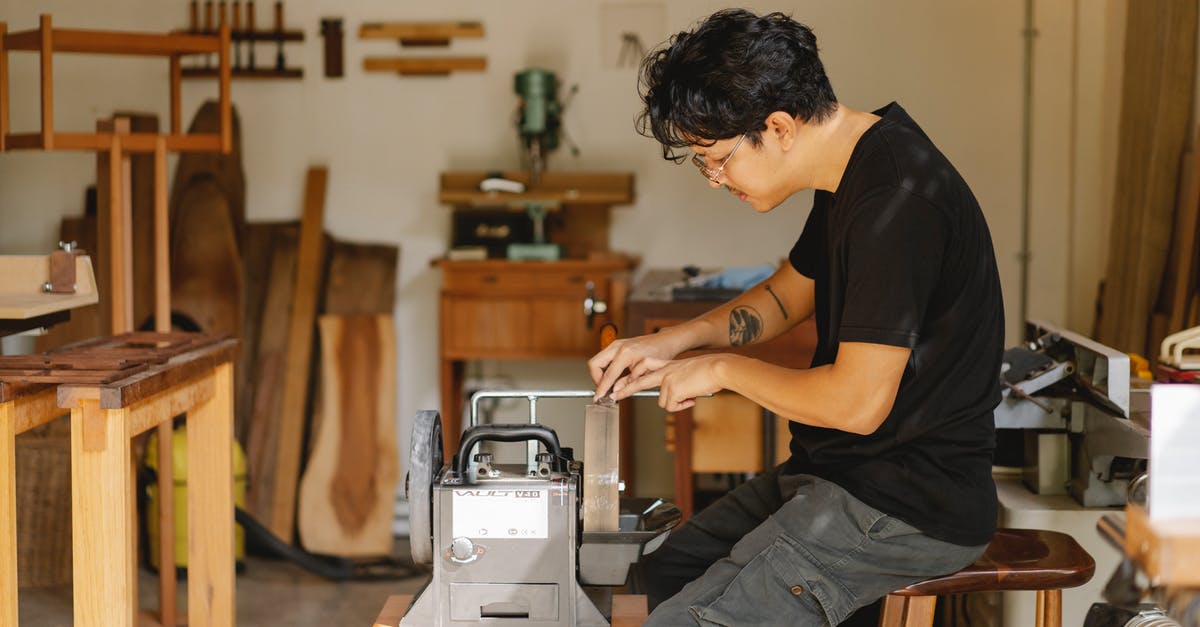Can I sharpen a knife with sandpaper?

So I was thinking, instead of purchasing a dedicated (and expensive) whetstone with limited coarse(ness?) range, why not use patches of sandpaper in increasing grit numbers (getting finer), stretched on some small flat surface? This way I can have as many grit steps as required, to the fineness level required, for relatively cheap and disposable?
Best Answer
Yes, I've heard this suggested, using wet/dry sandpaper and a mousepad. It is a very inexpensive way to match a whetstone, and you can use sandpaper with the same grit to produce an excellent edge.
You duct-tape the sand-paper together so it wraps around the mouse pad, and then pull the knife along the sandpaper with the edge trailing. This is to say, you use sandpaper in the opposite direction as a whetstone. Once you work up to the finest-grit papers, you can use jeweler's polish and a leather strop for a truly razor-sharp edge.
Because the mouse pad's rubber/foam has some give, this method produces a convex edge which remains sharp for longer that an V-cut, because it has more metal behind the edge. It also still presents a very sharp point for cutting, moreso than an equivalent V-cut front bevel.
Using sandpaper will also cost a small fraction of what you spend on a good sharpening stone, which will run you $50 or more PER STONE.
Wondering what grit to use? There are comprehensive tables here and here. However, here is a quick-reference mini-table for you:
Name / US Grit Rating / Use
- Coarse / 100-400 / Remove lots of metal. At the low-end of the range, used for reshaping blades, taking out large chips, or restoring snapped points. At the higher end of grit range, used to establish a bevel angle and restore very dull edges.
- Medium / 400-700 / Remove moderate amounts of metal. For refining an edge established with coarse grits, and for restoring moderately dull blades. Can be used to establish a bevel angle, but it will take considerably longer. 600 grit is a common point to start at for standard sharpening.
- Fine / 800-1200 / For finishing a blade or touching-up a slightly dull blade. At about 1000 grit, you will get something equivalent to a factory edge, assuming you use the same bevel angle. Ceramic steels have grits in this range.
- Extra-Fine / 2000+ / For polishing. Higher grits create a shinier and sharper edge, until at 8000+ grit you get mirror finishes and sharpness equivalent to a straight razor. If you're going to bother using grits this high, a leather strop and polishing paste may serve you better than even a ceramic steel; the steel would actually be reducing the edge sharpness with use.
Source: Sandpaper-mousepad sharpening
Source2: Sharpening techniques and explanation
Edit: Another way to use sandpaper in sharpening -- expanding the grit range for a Spyderco Sharpmaker
I'm currently using sandpaper to make a very coarse stone for sharpening extremely dull edges on my Spyderco Sharpmaker. I wrap both of the normal triangular stones with a strip of emery cloth or 220-grit wet/dry sandpaper, and then hold it in place with medium binder clips. Since the lowest stone the Sharpmaker comes with is 800-grit ceramic, this saves HOURS versus using the normal stones. It is also considerably cheaper than the diamond stones they sell; for a big tub of clips and a package of sandpaper, I paid $7, versus about $37 for the diamond rods.
Pictures about "Can I sharpen a knife with sandpaper?"



Quick Answer about "Can I sharpen a knife with sandpaper?"
One way of sharpening a knife with sandpaper is to cover a brick or block of wood with sandpaper and run the knife (lying flat) across it in a circular motion, making sure to spend equal time on each side of the knife. It will take a few minutes for each side.Is sandpaper good to sharpen knives?
I have for years used sandpaper for sharpening and polishing my plane blades and bench chisels in my woodworking shop. It works wonderfully well provided every stroke on the abrasive is exactly the same angle. Remember that the cutting edge is the union of two planes. The more uniform the planes, the sharper the edge.What is the best grit sandpaper for sharpening knives?
You may want to use 800, 1000, and 2000 grit sand paper at least. 200-400 grit sand paper is good for sharpening knife that is really dull and dinged up. If you want to sharpen you knife to help you shave hairs off, 2000 grit sand paper is the way to go.Can you sharpen a kitchen knife with sandpaper?
It's simple in theory, but sharpening a knife is all about the technique. We'll show you how to master that technique, so you can chop and dice with ease. All you'll need is your knife, a piece of fine and super fine sandpaper, a chopping block, and your honing steel (which usually comes with a set of knifes).KNIFE SHARPENING ON SAND PAPER
More answers regarding can I sharpen a knife with sandpaper?
Answer 2
I bought my (Chinese) whetstone for 7,5€ and I've used it for the last 20 years.
You could spend some money on a honing steel, but even these are not really expensive. I got mine for free at a fair, and it receives regular action.
Make sure you buy cheap vanadium steel knifes for your kitchen (shameless self-promotion).
Answer 3
If you're looking around your house for stuff you already own to sharpen your knife on, the story goes that the underside of a dinner plate is the way to go. I've never done it - I bought stones from Lee Valley many years ago and I have a steel, and between them I'm taken care of.
Answer 4
I have for years used sandpaper for sharpening and polishing my plane blades and bench chisels in my woodworking shop. It works wonderfully well provided every stroke on the abrasive is exactly the same angle. Remember that the cutting edge is the union of two planes. The more uniform the planes, the sharper the edge. I finish off with 6000 grit wet paper, it has the texture of a brown paper bag. I can see my reflection and readily shave hairs off my arm. The difference in usability of my woodworking tools is downright sexy. Why wouldn't this technique work with kitchen knives? Consider shopping at a thrift store for economical kitchen knives to practice on before going to work on your real knives. Try this website: http://www.woodbutcher.net/scary.shtml Do yourself a favor and skip to the condensed version; or grab a mug of Earl Grey and be entertained by the ramblings.
Answer 5
Sand paper does work on chisels. I had to have my oak kitchen floor repaired. The flooring expert just sat on the floor with an old cheap chisel and my rubber mallet. He stopped every 15 minutes or so to refine the edge. When he finished the repair, darned if I could find where he had worked. Note: The wood was Bruce pre-finished red oak strip. I used to sharpen my pen knife on 1000 grit garnet paper. However, I am not going to use this method on the very expensive kitchen knives. I will buy some water stones for that.
Sources: Stack Exchange - This article follows the attribution requirements of Stack Exchange and is licensed under CC BY-SA 3.0.
Images: Raghav Modi, Ono Kosuki, Ono Kosuki, Ono Kosuki
